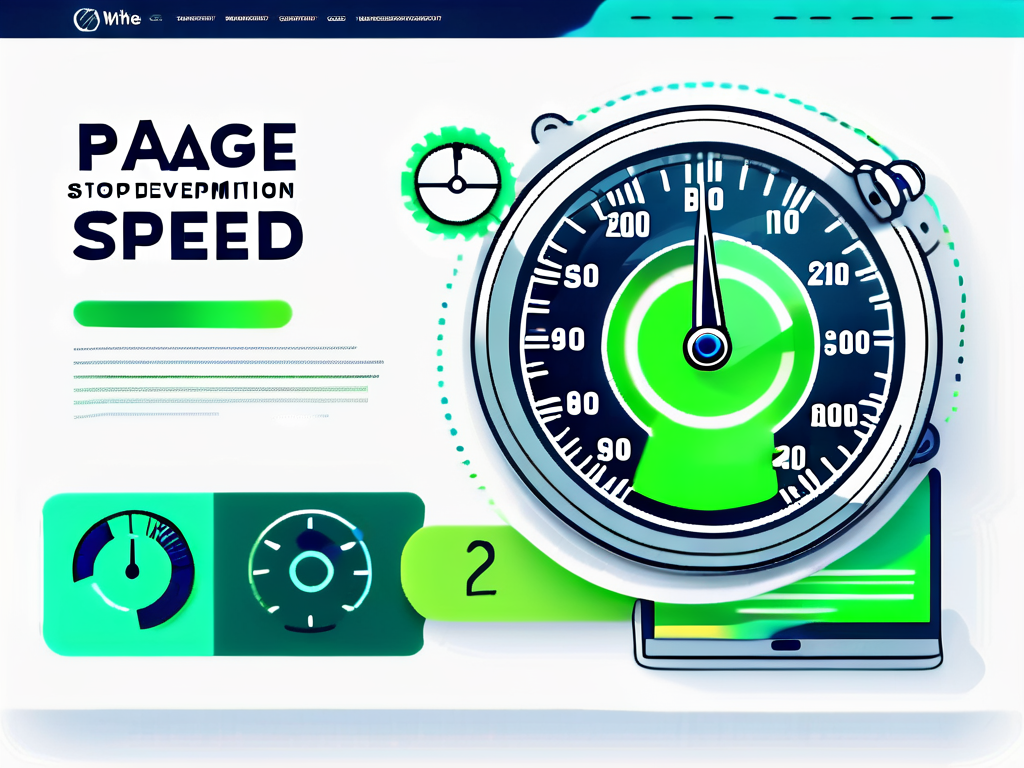The Ultimate Guide to Boosting SEO and Conversion Rates with Faster Page Speed
In today's digital age, having a fast-loading website is crucial for success. Not only does it enhance user experience and satisfaction, but it also plays a vital role in boosting your search engine optimization (SEO) and conversion rates. In this ultimate guide, we will delve into the world of page speed and explore its importance, the science behind it, strategies for improvement, the impact on mobile devices, and essential tools for testing and monitoring.
Understanding the Importance of Page Speed
When it comes to website performance, page speed is a deal-breaker. Users expect websites to load quickly, and if they fail to meet this expectation, they are likely to leave and never return. Furthermore, search engines, such as Google, consider page speed as a ranking factor, meaning that slow-loading websites may be pushed down in search results. To keep your visitors engaged and improve your search rankings, optimizing page speed is crucial.
One key aspect to consider when it comes to page speed optimization is the impact of images and multimedia content. These elements can significantly slow down a website if not properly optimized. By compressing images, leveraging lazy loading techniques, and minimizing the use of large media files, you can enhance your website's speed and overall performance.
The Connection Between Page Speed and SEO
Page speed and SEO share a symbiotic relationship. By improving your website's speed, you can enhance your SEO efforts and climb higher in search engine results pages (SERPs). Search engines prioritize delivering the best user experience, and speed is a significant component. A fast-loading website provides a positive user experience, leading to higher search rankings and increased organic traffic.
In addition to speed, mobile responsiveness plays a crucial role in SEO performance. With the increasing use of mobile devices for browsing, search engines now prioritize mobile-friendly websites. Ensuring that your website is optimized for mobile devices can further boost your SEO rankings and improve overall user experience.
How Page Speed Impacts Conversion Rates
Page speed isn't just about making your website pleasant to navigate; it also directly affects your conversion rates. Research shows that even a one-second delay in page load time can result in a 7% decrease in conversions. Users who have to wait for a website to load are more likely to abandon the process and seek alternatives. By maximizing your page speed, you can reduce bounce rates and increase the likelihood of users converting into customers.
Another critical factor in improving conversion rates is the optimization of your website's navigation and call-to-action buttons. Clear and strategically placed CTA buttons can guide users through the conversion funnel, while a well-structured navigation menu can enhance user experience and encourage visitors to explore more of your content, ultimately leading to higher conversion rates.
The Science Behind Page Speed
One cannot improve what they cannot measure, and page speed is no exception. Understanding the science behind page speed is crucial for optimizing it effectively.

Page speed is not just about how fast a page loads; it encompasses a variety of factors that contribute to the overall user experience. From server response times to browser rendering, every aspect plays a role in determining how quickly a user can interact with your website. By delving deeper into the intricacies of page speed, web developers can uncover hidden opportunities for enhancing performance and user satisfaction.
How Page Speed is Measured
Page speed is typically measured through several metrics, including First Contentful Paint (FCP), which measures how long it takes to render the first piece of content, and First Meaningful Paint (FMP), which measures the time until the primary content is visible. Other essential metrics include Time to Interactive (TTI) and Page Load Time. These metrics provide valuable insights into your website's performance and areas for improvement.
Moreover, the user's device and network conditions play a significant role in how quickly a page loads. Factors such as device processing power, network speed, and browser capabilities can all impact the perceived speed of a website. Understanding these variables can help developers tailor their optimization strategies to cater to a diverse range of users.
The Role of Web Hosting in Page Speed
Choosing the right web hosting provider directly influences your website's speed. Opting for reliable hosting solutions, such as cloud hosting or dedicated servers, can significantly improve load times. A well-scalable hosting infrastructure ensures that your website can handle high traffic volumes without compromising its speed and performance.
Furthermore, the geographical location of your web hosting server can also impact page speed. By selecting a server location that is closer to your target audience, you can reduce latency and provide a faster browsing experience. This strategic approach to server placement is especially crucial for websites with a global reach, as it helps minimize the time it takes for data to travel between the server and the user's device.
Strategies for Improving Page Speed
Now that you understand the importance of page speed, let's explore some effective strategies for optimizing it.

Optimizing Images for Faster Loading
Images play a crucial role in web design, but they can also be a significant factor in slowing down your website. To optimize images for faster loading, compress them without compromising quality, resize them appropriately for their display size, and utilize modern image formats such as WebP. Additionally, lazy loading images helps prioritize the loading of visible content while deferring off-screen images until the user needs them.
Leveraging Browser Caching
Browser caching involves storing webpage resources, such as images, JavaScript, and CSS files, on the user's device. By enabling caching, subsequent visits to your website can benefit from faster load times, as the resources are retrieved from the user's local cache instead of the server. Adjusting cache expiration times and utilizing Content Delivery Networks (CDNs) can further enhance this caching mechanism.
Minimizing HTTP Requests
Each HTTP request made by a user's browser adds latency to your website's load time. Reduce the number of requests by combining multiple JavaScript or CSS files into a single file, minify your code to remove unnecessary characters, and consider using CSS sprites to combine multiple images into a single file. By minimizing HTTP requests, you can significantly improve your website's speed.
Another effective strategy for improving page speed is to optimize your server response time. The time it takes for your server to respond to a user's request can greatly impact the overall loading speed of your website. To optimize server response time, you can consider upgrading your hosting plan to a faster server, optimizing your database queries, and implementing caching mechanisms on the server-side.
Furthermore, reducing the number of plugins and scripts on your website can also contribute to faster page loading. Each plugin or script adds additional code that needs to be processed by the user's browser, increasing the load time. Evaluate the necessity of each plugin or script and remove any that are not essential to the functionality of your website.
The Impact of Mobile Page Speed
In an increasingly mobile-driven world, ensuring optimal page speed on mobile devices is essential for engaging users and driving conversions.
The Importance of Mobile Optimization
Mobile optimization is no longer optional but rather a necessity. With more people accessing the internet through smartphones and tablets, it's vital to deliver fast-loading, mobile-friendly experiences. Google's mobile-first indexing also prioritizes mobile-friendly websites. A slow-loading mobile site can deter potential customers and harm your overall SEO performance.
Mobile Page Speed and User Experience
Mobile users are more likely to be on the go, relying on cellular connections and sometimes slower network speeds. Consequently, optimizing your website for mobile devices is crucial, as slow load times on mobile can lead to increased bounce rates and lost conversions. Implement responsive design, minimize content and code, and prioritize mobile page speed to create a seamless user experience.
Furthermore, mobile page speed not only impacts user experience but also plays a significant role in conversion rates. Studies have shown that even a one-second delay in page load time can result in a 7% reduction in conversions. This highlights the importance of fine-tuning your mobile site for speed to capitalize on potential leads and revenue.
Enhancing Mobile Page Speed Through Image Optimization
One effective way to improve mobile page speed is through image optimization. Large image files can significantly slow down loading times, especially on mobile devices with limited bandwidth. By compressing images, utilizing modern image formats like WebP, and lazy loading images below the fold, you can enhance the performance of your mobile site and provide a smoother browsing experience for users.
Tools for Testing and Monitoring Page Speed
To ensure your website maintains optimal page speed, utilize various tools that provide insights and allow for continuous monitoring.

Google's PageSpeed Insights
As a leading search engine, Google provides a useful tool, PageSpeed Insights, for measuring page speed performance. Simply enter your website URL, and it will analyze your site's performance across multiple devices, providing recommendations for improvement. Google's tool is an invaluable resource for optimizing page speed in accordance with search engine guidelines.
Furthermore, Google's PageSpeed Insights not only evaluates your website's speed but also offers suggestions on how to enhance user experience and boost your site's overall performance. By following the recommendations provided by this tool, you can ensure that your website is not only fast but also user-friendly and efficient.
Other Useful Tools for Page Speed Analysis
In addition to Google's PageSpeed Insights, several other tools can help you improve your website's performance. Tools like GTmetrix, Pingdom, and WebPageTest allow you to analyze various performance metrics, identify bottlenecks, and gain insights into how to enhance your page speed effectively.
GTmetrix, for example, offers a comprehensive analysis of your website's speed performance, providing actionable recommendations on how to optimize your site further. Pingdom, on the other hand, allows you to monitor your website's uptime and performance, alerting you in real-time if any issues arise. WebPageTest offers a detailed breakdown of your site's loading speed, highlighting areas for improvement and enabling you to fine-tune your website for better performance.
By utilizing a combination of these tools, you can gain a holistic view of your website's speed and performance, enabling you to make informed decisions on how to enhance user experience and drive better
